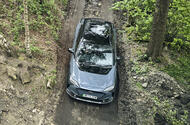Ex-McLaren special product boss wants to emulate brand’s heyday successes from the 1990s
After overseeing sales of the most exclusive JLR models at SVO and then the most exotic McLarens, including the Senna, Solus GT and Speedtail, a switch to running Subaru in the UK may not seem the obvious next move.
But Lorraine Bishton, who took the job in January, saw huge potential in leading a company that at its peak was one of the coolest brands in any industry in the UK – but in recent years had drifted into a state of mere existence.
For car-loving Bishton (pictured below), this was not only a chance to run a car company but also a chance to turn around a brand that, for all its troubles, is still well-loved by consumers.
That harks back to the late 1990s, when rally-bred Imprezas were the must-have performance cars, thanks to the exploits of Colin McRae and Richard Burns in the World Rally Championship.
But all good things eventually come to an end, and as the WRC-era cars gave way to the rise of Germans in the early 2000s, Subaru lost its sparkle and settled back into its other image: a maker of cars for geography teachers who wore jackets with leather arm patches.
That’s not a lazy stereotype on my part: remarkably, a Subaru executive offered that description unprompted at a Car of the Year event for the launch of the Solterra EV in 2022.
Bishton, one of Autocar’s Great Women in the Executive category for 2024, was headhunted for the role and started in January, where she found a “very well-loved brand” but one where “perhaps people are confused” by what it is.
“They speak fondly of Subaru but perhaps don’t know what it stands for,” she told me.
She wants to sell the Japanese brand as one that’s “safe, tough and fun”, with cars “that are an extension of the family” and “spec for spec, the best value in their segments”.
That latter point is one Subaru is already living up to, Bishton claimed.
“They’ve very capable but also comfortable and can go off-road. If you want a car that gives you the confidence to enjoy life and adventures, that’s what Subaru is.”
The ambitions for Subaru in the UK remain modest in absolute terms, with a goal of heading back towards its 1990s peak of around 12,000 units – although that’s still almost five times its 2023 volume.
In 2024, Subaru’s registrations were up 30% in the first half of the year, and Bishton spoke of a strong product pipeline, if also growth tailing off in the short term, due to more restricted supply.
Subaru is well ahead of the ZEV mandate target for 22% of total sales to be EVs, too, while the Solterra has also exposed it to a meaningful fleet audience for the first time in a generation. Just over a quarter of Subaru’s UK sales now come from fleet buyers.
Its 65 dealers have remained engaged with the brand throughout its recent fallow period, rooted and active in local communities by supporting local events. There are no plans for the agency model at Subaru to that end.
Subaru Corporation is a modest company. In January, it opened a new $200 million Subaru design and innovation centre in Japan to little fanfare.
As well as developing an $8 billion new generation of EVs that will make up the bulk of the Subaru range by the end of the decade (Bishton said the UK is respected and listened to and its “big say in products” belies its size), the site will further develop safety technology as part of Subaru’s laudable goal for zero deaths in its vehicles by 2030.
And while the geography-teacher image may be one that Subaru is keen to shake, its role as a responsible corporate citizen is being recognised in the right places.
Subaru was ranked second in the US in Forbes’ best brands for social impact list, not just for car companies but across all sectors. It remains a big brand in the US, too, with sales of around 600,000 cars making this by far its biggest global market.
Bishton knows Subaru’s glorious past can be helpful in achieving success in the future. She said it was a “missed opportunity” to not talk about the brand’s motorsport activities and said Subaru UK will start to “celebrate its heritage” more as its next era of cars arrives – something she has experience with and a blueprint of from her time at McLaren.
After spending time with Bishton, you can see why she made the switch from Sennas to Subarus – and the potential for the brand’s best days to still be ahead of it.
Source: Autocar
